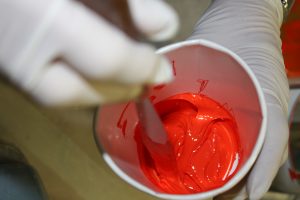Ink Adhesion Part 3: Ink Mixing, Contamination, Blooming and Mold Release Agents
Comments Off on Ink Adhesion Part 3: Ink Mixing, Contamination, Blooming and Mold Release Agents Before printing on any parts there are several factors which are of vital importance: ink mixing, product cleanliness and substrate additives. Regardless of proper ink preparation and chemistry, surface contamination, blooming and mold release agents may all interfere with your ability to achieve satisfactory adhesion.
Before printing on any parts there are several factors which are of vital importance: ink mixing, product cleanliness and substrate additives. Regardless of proper ink preparation and chemistry, surface contamination, blooming and mold release agents may all interfere with your ability to achieve satisfactory adhesion.
The two most important factors that must be addressed when dealing with ink mixing are: How are you mixing the ink? What components are you using? Inks are formulated to be mixed at specific ratios, and any deviation may result in adhesion failure. You must choose the correct ink and mix it to the exact manufacturer specifications. It is a common misconception that adding hardener over manufacturing specifications will allow for better adhesion.
Surface contamination is a huge factor in whether or not the ink will adhere to any given object. The first reason contamination may occur is because people are not handling the object correctly. Oils on the handler’s hands can be transferred onto the objects. Contamination can also occur as a result of secondary processes being performed on the parts. For instance, if you choose to wash the objects with a detergent, this may leave a residue behind on the object and the ink may not adhere properly. Here at EPS we use alcohol. This is a standard solution which readily flashes off and is used to wipe the parts of any dust, oils or any contaminants before printing. With proper handling, cleaning the parts may be unnecessary, but wiping with alcohol does assure that there will be a clean surface to print on.
Blooming is a term used in the plastic industry and it denotes a plasticizer or other additive coming to the surface of a part over time. The difficulty with this contamination is that you can wipe the surface of the part free of contaminates but over time the part will re-bloom and the contaminants will interfere with the bond between the ink and the parts.
Mold release agents (also known as de-molding agent, form oil, parting agent or release) are substances used in molding and casting that aid in the separation of a mold from the material being molded and reduce imperfections in the surface. While these additives make the plastic manufacturing process simpler, they can wreak havoc on attempts to achieve adhesion.
In the end, experience is the best weapon in attaining adhesion. If you have any questions or concerns please contact Technical Service. For more information about Engineered Printing Solutions’ custom solutions, standard pad printers, industrial digital ink jet, consumables and other auxiliary equipment, email sales@epsvt.com or call 1-800-272-7764.

